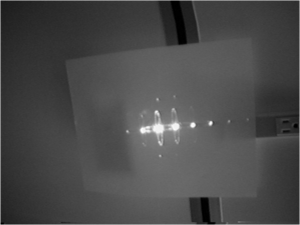Koch Lab:Research/AOD tidbits: Difference between revisions
| Line 11: | Line 11: | ||
==[[/AOD Loops|Amazing diffraction patterns caused by acousto-optic effects]]== | ==[[/AOD Loops|Amazing diffraction patterns caused by acousto-optic effects]]== | ||
Schaefer-Bergmann diffraction | [[Image:Loops.png|right|thumb|Loops]] | ||
The diffraction pattern shown in the picture is the result of shining a HeNe laser through an AOD designed for use with a 1064 nm laser. So, this is not the correct usage of the AOD, but the pattern displayed is similar to what Steve saw using a 1064 nm beam (visualized either with an IR card or possibly by viewing with a CCD camera) and it was much easier at the time to take a picture of a visible laser beam. Steve found the pattern amazing, first because it just looks cool, and second because the simple understanding of acousto-optic diffraction (Bragg diffraction) cannot explain the crazy loop diffraction. Steve actually walked to the engineering library (in the old days of the 1990s you had to go to the library) and photocopied some papers which indicated that this was due to Schaefer-Bergmann diffraction. Schaefer-Bergmann diffraction surprisingly doesn't have a wikipedia article, but is due to acousto-optic diffraction in birefrigent materials. Steve never got far enough to understand this. | |||
Comparison with the cross-hatching beam distortion indicates that the loops are possibly the root cause of the AOD cross-hatching and detector wiggles? | |||
<br style="clear:both;"/> | |||
==[[/AOD Crosshatch Pattern|Crosshatching in laser caused by AOD]]== | ==[[/AOD Crosshatch Pattern|Crosshatching in laser caused by AOD]]== | ||
[[Image:Beam before AOD.JPG|thumb|Before AOD]] [[Image:Beam after deflection through AOD.png|thumb|After AOD]]<br style="clear:both;"/> | [[Image:Beam before AOD.JPG|thumb|Before AOD]] [[Image:Beam after deflection through AOD.png|thumb|After AOD]]<br style="clear:both;"/> | ||
==[[/AOD Efficiency|Efficiency and "flatness" of AODs]]== | ==[[/AOD Efficiency|Efficiency and "flatness" of AODs]]== | ||
Revision as of 23:01, 19 June 2007
During grad school, Steve spent a bunch of time monkeying around with AODs (acousto-optic deflectors, see: wikipedia:AOM) during the construction of otpical tweezers. He spent sometimes months over-analyzing some of the problems encountered and accumulated a lot of data that hasn't been published. He'd like to put that data on OWW to save time for others who may encounter those problems.Send Steve a note if you would like more information about these things--a note will make him motivated to post things sooner!
Wiggles caused by AOD on the quadrant photodiode

After aligning the optical tweezers (at Cornell, Wanglab, see Koch_Lab:Publications 2002 Biophys J article) Steve, Richard and others discovered that using our AOD to steer the optical trap in the sample plane produces huge "wiggles" on the detector. These wiggles could add as much as 10 nm of error into the detection signal, which was unacceptable. Steve studied the hell out of this for over a month and in the end, use of the AODs for other than intensity modulation was abandonded, and the piezo stage was used for 1-D stretching. Many unpublished things were discovered along the way, which could be useful to other optical tweezers labs or others using AODs. Some of our thoughts:
- Wiggles definitely caused by AOD and a repeatable function of frequency and AOD power
- Wiggles perhaps worse due to imaging of AOD onto detector (many labs image a plane between the AODs, which may temper the wiggle problem)
- A wiggle subtraction array can be used, level of success unknown (Steve et al. used an "offset array" subtraction, which accounts for the wiggles at a fixed frequency, variable AOD power).
- Wiggles are probably not in focus in sample plane and so do not affect the trapping force...so a separate detection beam probably negates wiggles problem.
Amazing diffraction patterns caused by acousto-optic effects

The diffraction pattern shown in the picture is the result of shining a HeNe laser through an AOD designed for use with a 1064 nm laser. So, this is not the correct usage of the AOD, but the pattern displayed is similar to what Steve saw using a 1064 nm beam (visualized either with an IR card or possibly by viewing with a CCD camera) and it was much easier at the time to take a picture of a visible laser beam. Steve found the pattern amazing, first because it just looks cool, and second because the simple understanding of acousto-optic diffraction (Bragg diffraction) cannot explain the crazy loop diffraction. Steve actually walked to the engineering library (in the old days of the 1990s you had to go to the library) and photocopied some papers which indicated that this was due to Schaefer-Bergmann diffraction. Schaefer-Bergmann diffraction surprisingly doesn't have a wikipedia article, but is due to acousto-optic diffraction in birefrigent materials. Steve never got far enough to understand this.
Comparison with the cross-hatching beam distortion indicates that the loops are possibly the root cause of the AOD cross-hatching and detector wiggles?
Crosshatching in laser caused by AOD

